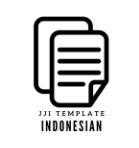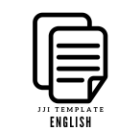GUIDELINES FOR AUTHORS
Public Policy
Jurnal Jamu Indonesia (Indonesian Journal of Jamu) publishes manuscripts in Indonesian and English in all fields related to herbal medicine. Manuscripts can be in the form of recent research reports, explanations of new research methods, or new understanding of existing results. Recent theoretical contributions can also be equated with research papers. The interpretation of the above policies is the authority of the editor who will decide whether a submitted manuscript meets the criteria or not. Submission of a manuscript to Jurnal Jamu Indonesia implies that the manuscript is not being published, nor is it under consideration for publication anywhere. Indonesian Jamu Journal is published twice a year.
Editor and Review Process
The editor has responsibility for all editorial decisions. The names of the editors are listed in each issue, while the list of reviewers is published in the last issue of each volume. Manuscripts received by the editor will be sent to reviewers who have competence in their fields. Authors can submit reviewers' names for their manuscripts and submit them online when submitting their articles. Jurnal Jamu Indonesia will accept it as a suggestion, but it is not obligatory to follow the suggestion.
The reviewer is an advisor to the editor. The results of the review are used as a consideration for editorial decisions to accept or reject a manuscript. If a manuscript is rejected, the editor will send this decision to the author along with the opinion of the reviewers. When the manuscript is returned to the author for revision (for accepted manuscripts), the author must return it together with a statement from the reviewer and a letter indicating that revisions have been made. Revised manuscripts must be returned within 30 days at the latest. Delay will cause the manuscript to be considered as a new submission and may undergo a new review process.
Publication on the Internet
Accepted manuscripts will be published on the internet as soon as the Journal is ready to be published. Access can be made at the URL: http://jamu.journal.ipb.ac.id.
Submission of Manuscripts
By following these general rules it is hoped that a short time between acceptance and publication of the manuscript can be achieved. Sent no later than three months before publication addressed to: Dr. Waras Nurcholis, S.Si., M.Si., online at http://jamu.journal.ipb.ac.id.
Manuscript Category
Manuscripts that can be submitted are reviews, communications, and original research articles. All submitted manuscripts will go through a review process prior to publication.
Research manuscript
Complete manuscript, which is a general form of publication whose contents can be accounted for.
Research communication
In the form of a short text, a maximum of 3 pages contains important findings that can interest those involved in the field of herbal medicine.
Review
Unsolicited feedback may be considered for publication after previously submitting a summary or outline.
MANUSCRIPT FORMAT
Get the manuscript template here.


The manuscript is created using MS Word software using the template provided above. The manuscript uses a Charis SIL with 12 pt font size and 1.5 line spacing. The title is in English and Indonesian. The title should be precise, catchy but informative enough, and no abbreviations. Manuscripts are named after the authors and their respective affiliated institutions indicate ownership of the manuscript and put an * mark for the correspondence author. The title must be no more than 20 words and no abbreviations.
The paper's abstract is in English and Indonesian and is at most 250 words. Keywords contain important words in the paper that can be used for index reference. Keywords are placed after the abstract with a total of between 3-5 words. The main body of the manuscript is divided into (a) Introduction; (b) Research methods, including materials and methods; (c) Results and Discussion; (d) Conclusion; (e) Acknowledgments; (f) References. Tables and figures are placed after the references.
Referring to the literature on cited writing in the following way (APA 7th edition):
(Djohari et al., 2021)
(McCann & Ratneswaran, 2019)
Djohari, M., Febrina, M., & Wahyuni, T. (2021). In Vivo Antihypercholesterolemic Potential of Uncaria cordata (Lour.) Merr as Ethanolic Extract. Majalah Obat Tradisional, 26(3), 155–160. https:// doi.org/10.22146/mot.64531
McCann, M. R., & Ratneswaran, A. (2019). The role of PPARγin childhood obesity-induced fractures. Genes and Nutrition, 14(1), 1–11. https://doi.org/10.1186/S12263-019-0653-7/FIGURES/1
Writing special tools, materials, and software follows the following procedure:
Equipment: instrument name and type (Manufacturer, City, Country of Manufacture, City, Country of fig), for example: 1700 PC UV-Vis spectrophotometer (Shimadzu, Kyoto, Japan)
Ingredients: name of ingredient and purity if available (Manufacturer, City, Country), example: quercetin 99% (Sigma-Aldrich, St Louis, USA)
Software: software name with version (Maker, City, Country)
example: The Unscrambler version X 10.2 (Camo, Oslo, Norway).
DETAILED DESCRIPTION OF THE SCRIPT SECTION:
Introduction:
This section is presented briefly, explaining the background and reasons why the research (study) was carried out. This section could be a review or study of literature. The Introduction clearly states the current scientific status (state of the art). The number of references and the number of paragraphs (3-4 paragraphs) is limited. A statement of research objectives that is explicitly written in the last paragraph along with a brief description of the approach to solving the problem. Statements of research benefits are not recommended to be written in the Introduction; if the research findings are in fact useful, write this in the conclusion.
Research Methods:
The section explaining the stages of the research and the following rules should be explained, even if there is a complicated set of experiments, it is also allowed to explain each rule before the presentation of the results. The method must be described in sufficient detail to allow the experiment or data acquisition to be repeated by others. Routine methods need to be briefly described with additional complete references. Equipment manufacturers, sources of chemicals, and drugs must be known. Calculations and statistical methods used are also included here.
What became the focus of the reviewer when examining the method section was the accuracy and legitimacy of the materials, tools, procedures, data collection and data analysis. If the method refers to a standard procedure, write down the default. What is meant by standard procedures are: standard procedures generally issued by the government (for example: SNI from the Indonesian government, JIS from the Japanese government,) or institutions (eg: ASTM, AOAC), or procedures that have been published. Do not refer to practical procedures.
Results and Discussion:
The presentation of the results is not merely a repetition of data that appears through illustrations (tables and pictures). The results section should be clear and follow a logical sequence. If the text describes a complex series of experiments, it is permissible to explain the rules or stages of the experiment before presenting the results. Do not discuss results or draw conclusions in this section. Often illustrations require editing as well, for example reducing or enlarging the size. In general, illustrations are not allowed to be inserted in the text. For this reason, each illustration needs to be numbered sequentially and stated in the text so that the editor does not place it in the text incorrectly.
What is criticized in the discussion is the author's ability to interpret the data collected and synthesize it to arrive at meaningful conclusions on the progress of science and technology. The discussion is not just narrating the results, the relationship that exists between the facts during the observation must be shown; don't be impressed. The author's ingenuity is shown through logical argumentation to interpret and give implications, using quality references in this case. Limitations of the findings if any should be pointed out honestly. The implications of the research results need to be stated, don't overdo it and speculate. All information is packed in good paragraphs. Never refer to references at the beginning of a paragraph. State your thoughts at the beginning of the paragraph and support it with some relevant literature. Close the paragraph with a general statement, such as a small conclusion.
Conclusion:
In conclusion, give the impression that your research is really useful for readers to read or cite.
Acknowledgment:
Give briefly and only convey to appropriate parties, such as funders (sponsors), material donors, research facilities and sources of assistance with materials that cannot be obtained commercially. If you receive a research grant from a sponsor, write down the contract number as well.
References:
Prepare the bibliography with bibliographic software such as Mendeley, Zotero, EndNote, etc, in APA 7th Edition to avoid typing errors and duplicate references. Include a digital object identifier (DOI) for all references if available.
The reference list style can be found at http://www.zotero.org/styles/apa and can be downloaded with the bibliographic software used.
Table:
Give each table a short and clear title, and place an explanation of the table in the footnotes. Explain any use of abbreviations also in footnotes and identification and explain all statistical measurements (standard deviation and error) and analysis (ANOVA, etc.). The table consists of 5 main parts, namely table number and title, stump head (leftmost column, stub), column head, information field, and table footnotes. There are only 3 important dividing lines, the direction is horizontal, and the remaining auxiliary lines must be made as needed. Vertical guide lines can be removed by carefully arranging columns and spacing between columns.
Figure:
Images must have a minimum resolution of 300 dpi (dots per inch).
Loading fee
Jurnal Jamu Indonesia has not yet implemented a loading fee including manuscripts to be published.
Correct
If an error is found in a published manuscript, the author should send the correction to the editor for publication as an error.
Manuscript Withdrawal
Authors are not permitted to withdraw manuscripts that have been submitted because, in the submitting process, there is already an agreement that this article is not in/is under review/published late in other journals. It has also wasted valuable editor and/or reviewer time. Editors and reviewers have spent much time processing submitted manuscripts, fees, and work invested by publishers.
If the author still requests the withdrawal of the manuscript while the manuscript is still in the peer-review process, the author will be fined IDR 500,000 per manuscript as a withdrawal penalty to the Publisher. However, it is unethical to withdraw a manuscript submitted from one journal if it is received by another. Manuscript withdrawal after the manuscript is accepted for publication, the author will be fined by paying IDR 1,000,000 per manuscript. Manuscript withdrawal is only permitted after the withdrawal penalty has been fully paid to the Publisher.
If the author does not agree to pay the fine, the author and his affiliates will be blacklisted for publication in this journal.

